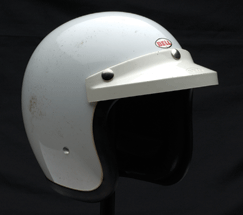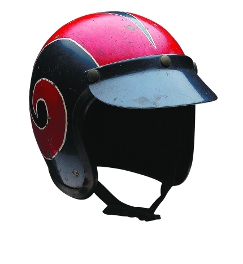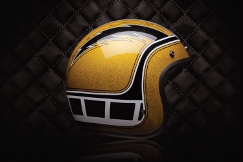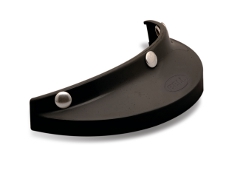The motorcycling world is one full of iconic moments. Hopper and Fonda streaking across the States in a blaze of narcotics, Brando or McQueen on a Triumph, the Girl with a Dragon Tattoo on a Honda CL–350 or er… Street Hawk? But what of the equipment surrounding them?
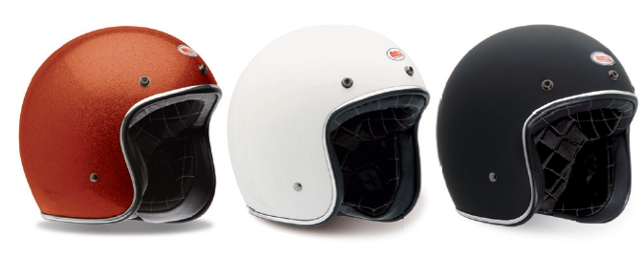
Bell Sports’ new Custom 500 range pays homage to the original 1954
There are plenty of products that have achieved iconic status alongside these events from popular culture. Look back through some of the greatest moments where motorcycling and culture collide and you’ll find the Bell 500 helmet, which was first launched in 1954.
With its slim, spartan profile it has become associated with motorcycle riders who eschew the confines of full face protective wear for freedom and wind in the face. But how does a company keep such a design alive? Is it purely about branding or are more technical updates and developments required?
The Bell 500 was the first product that California-based Bell Sports launched and it was an immediate success. The company has since moved into the growing action sports fields and now produces a wide range of sports helmets and accessories.
This success meant that the Bell 500 took a back seat as the in-house design team pursued newer opportunities. At the same time, other helmet manufacturers took the cues from the Bell 500 and started to produce similar, copy–cat products.
In 2001, Casey Potter joined Bell Sports as creative director. With a diverse background including stints at Hasbro, frogdesign and snowboard company, Sessions, Potter saw a missed opportunity as competitors took advantage of a company distracted.
Resurgence of interest
According to Potter, “We saw the resurgence in popularity of cafe racers and vintage custom motorcycles. Guys that weren’t wearing helmets before wanted them and they wanted that original 500 profile.”
The rise of online auction sites such as eBay gave the team insight into how the vintage Bell helmets were perceived in terms of both desirability and value. Potter saw that riders were “Going online, buying original Bell 500TXs for 500 bucks with completely roached out liners and were wearing them.”
The US motorcycle helmet industry is a curious beast. Some states require helmets to be worn, others do not. Some require that basic head protection is required, but with no specific requirements in protection – referred to as a novelty helmet.
Others enforce US Department of Transportation requirements, known colloquially as DOT approval.
As Potter points out, this gave Bell’s competition a problem. “If the competition wanted the same slim profile as the 500, they were a novelty helmet.
However, if they wanted to manufacture a DOT approved helmet, they had to have a much larger liner which gave a much bigger appearance and many riders weren’t satisfied with the looks.”
Redesigning an icon
Potter delivered a battle cry to Bell Sports’ development team; “First off , we’ve got these other companies that are ripping off our heritage and claiming ownership of this design when it’s ours.
So at the very least, we need to own our own history and get something out there that’s really Bell. Secondly, we need to make something that not only has the correct look to it but which meets modern DOT standards.”
This process of taking an iconic, but legislatively out of date, design took three years. Potter and the team went about updating not only the design of the 500 (without changing its classic profile), but also the method of manufacture.
The current Bell 500 is a system-based design. The glass re-enforced fibre shell combines with the expanded polystyrene (EPS) liner to create a complete product.
The fibre layup has to be done correctly to provide the required impact protection, but much of that safety also comes from the EPS liner working in concert with the shell.
Design parameters, from the order and orientation of the lay-up process working with the materials, are used to satisfy the legal requirements from the DOT.
Those all important safety standards are something that Bell takes very seriously. “Here at Bell, when we talk about passing DOT standards, we’re not talking about squeaking by and barely meeting the standard. We aim to always pass with room to spare,” says Potter.
The end result is a core product that takes a 50 year-old design and brings it up to date with today’s materials and processes as well as safety requirements. “It had to look right and function to our standards.
It’s a helmet that looks very ‘old school’ and very retro, but it actually takes a lot of research and development to achieve that style,” comments Potter. “All of the technology is completely hidden in that helmet.
In order to achieve the slimmer design, it took a lot of work.”
Keeping a classic fresh
Alongside the redevelopment work, Potter and his team at Bell have been working to ensure that the product is kept fresh with new graphic designs for each season.
This is something that’s key to keeping the product up to date and attracting new customers. “Even when I’m working with our in-house designers, I want them to look outside power-sports and outside our competitors for inspiration,” he explains.
“Design can become a cannibalistic cycle where we’re looking at somebody else and aping their designs, while they’re looking at us and doing the same. It just goes around in circles.”
To break out of this cycle, Bell has built up partnerships with a number of key artists from fields often disconnected to the power sports world. “I started an artist series where I would find artists that I thought had a certain aesthetic and style that was complimentary to Bell, but weren’t necessarily artists designing helmet graphics.”
While this is done across the company’s expansive product range, the authenticity is particularly important when it comes to the 500.
“I wanted authentic artists that really identified with that style, so instead of myself or one of my designers creating a graphic that looked like an old school hot-rod pinstripe, I wanted an actual pinstriper, a guy that built hot-rods, that lived and breathed it and was authentic.
If nothing else, Bell needs to be authentic,” stresses Potter. This ethos is fed by the no–nonsense design of the helmet itself, where extraneous details are stripped away to create a very simple, functional design.
One such artist that Bell teamed up with is Skratch, a Californian hot-rod fabricator and custom graphics specialist.
Another is a former sponsored road racer, Roland Sands. Sands grew up in and around his father’s Performance Machine aftermarket parts business, raced professionally, then created Roland Sands Design, a well known company in custom motorcycle circles.
According to Potter, the collaborations bring an edge to Bell’s products that is missing from other brands.
“Instead of looking around and thinking “Let’s make something like that”, we’re looking at who’s really doing a great job, who we can partner with and build a cool story around when it comes to design.
We’ve got a lot of amazing designers in house that do very cool work but these artist collaborations have been really great for us.”
It is clear that everyone at Bell has a passion for motorsports and that infl uences its design, development and styling decisions. In fact, the design team often spend afternoons together riding motorcycles.
Enough to make any motorcycle fan jealous.
Bell Sports’ history
Bell Sports founder, Roy Richter, was an auto racer who lived and breathed the world of gas powered excitement.
As a teenager, he worked at an auto parts store called Bell Auto Parts. Working his way up through the ranks, he eventually bought the company and turned it into one of southern California’s original speed shops in the 1950s, providing parts and equipment in a nascent post-war racing scene.
But with success and speed came tragedy. Richter saw a lot of his friends and customers killed whilst racing. With the concept of motorcycle racing so new, equipment was thin on the ground and those early riders used leather helmets from the sports field, which really provided very little protection if they fell off.
After the death of a close friend, Richter realised that while he might not be able to talk friends out of their passion, he might be able to make them safer. Looking at the facilities available to him, he developed the idea of using laying up glass fi bre to create a more suitable protective device.
The Bell 500 came to market in 1954. Early models used leather webbing to suspend the shell around the rider’s head, but they still didn’t give the protection he desired.
After a chance encounter with a British company called Toptex, who manufactured motorcycle helmets for the country’s police forces, Richter licensed the technology for auto sport use and the final form
of a legend was beginning to take shape.
The Bell 500 XT was put into production in 1962 and a legend was born.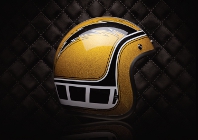
Redesign breathes new life into classic motorcycle helmet
Default


